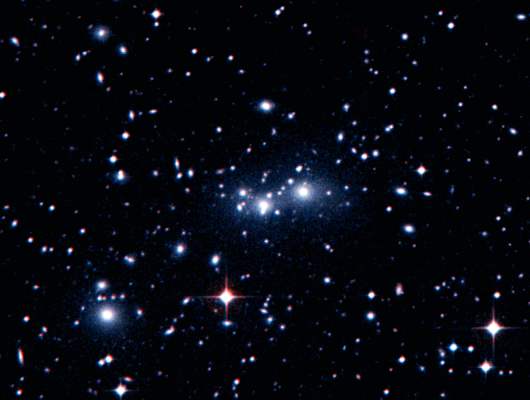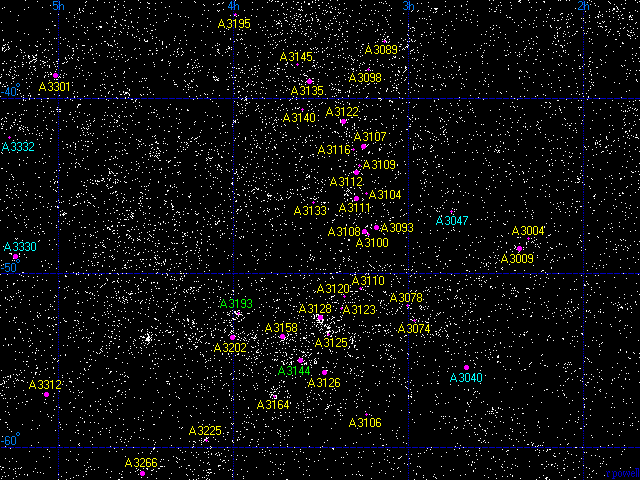
The Horologium Supercluster is a gigantic supercluster with a length of about 550 million light years. This map shows every galaxy brighter than magnitude 17 (from the HyperLeda database) in this area of the sky. All of the major clusters of galaxies in the Horologium supercluster are marked. The nearest part of this supercluster (mainly the clusters near the bottom of the picture) is 700 million light years away but the far end (mainly the clusters at the top) is 1.2 billion light years from us. There are no other superclusters within a billion light years which are as big as this.

Below is a list of the major clusters of galaxies in and near the Horologium Supercluster. There are about forty clusters in this list, which is a much greater quantity than most other superclusters. This list is probably not complete. There are a lot of other clusters in the Abell catalogue in this region of the sky which do not have a published redshift and hence have an unknown distance - a few of these clusters are probably also in the Horologium Supercluster.
1 2 3 4 5 6 7
Abell Equatorial Redshift Distance Rich Notes
Number Coordinates z Mly
RA Dec
A3004 02 18.9 -48 00 .0619 840 0
A3009 02 22.1 -48 34 .0641 865 1
A3040 02 40.1 -55 25 .0920 1225 1 background cluster
A3047 02 45.2 -46 27 .0938 1250 0 background cluster
A3074 02 57.9 -52 43 .0718 965 0
A3078 03 00.5 -51 50 .0636 860 0
A3089 03 08.2 -36 43 .0655 885 0
A3093 03 10.9 -47 24 .0818 1095 2
A3098 03 13.7 -38 19 .0821 1100 0
A3100 03 13.8 -47 48 .0617 835 0
A3104 03 14.3 -45 25 .0718 965 0
A3106 03 14.5 -58 06 .0627 850 0
A3107 03 15.4 -42 46 .0863 1155 1
A3108 03 15.2 -47 38 .0613 830 1
A3109 03 16.7 -43 51 .0908 1210 0
A3110 03 16.5 -50 54 .0737 990 0
A3111 03 17.8 -45 44 .0763 1025 1
A3112 03 17.9 -44 14 .0738 995 2
A3116 03 19.0 -42 56 .0818 1095 0
A3120 03 21.9 -51 19 .0678 915 0
A3122 03 22.3 -41 20 .0631 855 2
A3123 03 23.0 -52 01 .0632 855 0
A3125 03 27.4 -53 31 .0577 785 0
A3126 03 28.7 -55 43 .0844 1130 1
A3128 03 30.2 -52 34 .0587 795 3 'Shapley 20'
A3133 03 32.7 -45 57 .0522 710 0
A3135 03 34.0 -39 00 .0630 850 2
A3140 03 36.3 -40 38 .0608 825 0
A3144 03 37.1 -55 01 .0431 590 1 foreground cluster
A3145 03 37.9 -38 01 .0592 805 0
A3158 03 43.0 -53 39 .0585 795 2 'Shapley 17'
A3164 03 45.8 -57 03 .0558 760 0
A3193 03 58.2 -52 20 .0345 475 0 foreground cluster
A3195 03 59.2 -35 11 .0738 995 0
A3202 04 00.2 -53 40 .0681 920 1
A3223 04 08.6 -30 49 .0589 800 2
A3225 04 09.3 -59 36 .0537 730 0
A3266 04 31.2 -61 29 .0577 785 2
A3301 05 00.8 -38 41 .0524 715 3
A3312 05 03.9 -56 56 .0526 715 2
|
Below is a list of other major groups of galaxies in the vicinity of the Horologium supercluster. These are all groups which contain many tens of galaxies but which were not significant enough to be included in the Abell catalogue. This is a fairly random selection, there are a lot of groups in this area which do not have a published redshift. The foreground groups in this list are interesting because together with the A3144 and A3193 clusters they form part of a smaller supercluster in front of the Horologium supercluster at a distance of 550 million light years (redshift 0.040).
1 2 3 4 5 6 7
Group Equatorial Redshift Distance Rich Notes
Name Coordinates z Mly
RA Dec
S239 02 16.8 -47 49 .0635 860
S250 02 22.3 -51 06 .0484 660 foreground group
S261 02 25.2 -63 14 .0574 780
S274 02 31.2 -57 56 .0309 425 foreground group
S315 02 59.2 -51 01 .0618 835
S324 03 10.0 -47 20 .0585 795
S329 03 12.6 -49 38 .0531 720
S336 03 17.5 -44 42 .0744 1000
S338 03 18.2 -52 15 .0384 525 foreground group
S339 03 19.3 -53 52 .0546 740
S346 03 22.4 -49 19 .0670 905
S353 03 26.4 -51 25 .0410 560 foreground group
S366 03 34.9 -53 35 .0598 810
S367 03 35.5 -45 10 .0666 900
S372 03 37.2 -55 25 .0758 1020
S377 03 40.7 -55 12 .0425 580 foreground group
S390 03 47.0 -54 02 .0605 820
S393 03 48.3 -45 33 .0454 620 foreground group
S399 03 54.5 -53 48 .0394 540 foreground group
S404 03 56.4 -53 52 .0365 500 foreground group
S412 04 01.7 -56 54 .0467 635 foreground group
S413 04 02.7 -63 48 .0370 505 foreground group
S416 04 04.8 -43 51 .0648 875
S424 04 07.6 -43 25 .0589 800
S433 04 14.5 -50 48 .0668 909
S461 04 28.2 -50 32 .0539 735
S463 04 29.2 -53 50 .0394 540 foreground group
S468 04 31.7 -46 07 .0675 910
S479 04 37.8 -51 26 .0363 500 foreground group
S487 04 40.4 -44 38 .0372 510 foreground group
S497 04 46.1 -44 44 .0329 450 foreground group
S501 04 50.1 -51 08 .0768 1030
|
Column 1: The name/number of the cluster or group.
Column 2: The Right Ascension for epoch 2000.
Column 3: The Declination for epoch 2000.
Column 4: The redshift of the cluster.
Column 5: The distance in millions of light years assuming H=70km/s/Mpc.
Column 6: The 'richness' class of the cluster (for Abell clusters only).
Column 7: Additional names and notes.
References:
Abell G, Corwin H, Olowin R, (1989), A catalogue of Rich Clusters of Galaxies,
Astrophys J Supp, 70, 1.
Struble M, Rood H, (1999), A compilation of redshifts and velocity dispersions for
ACO clusters, Astrophys J, 125, 35.
Below is a map of the Horologium Supercluster. This map shows a side-view of the supercluster. All of the Abell clusters in and near the supercluster are labelled. The nearest part of the supercluster to us is at the top-right where the A3133 cluster is. This supercluster is much, much larger than most other superclusters. Compare this supercluster with the Perseus-Pisces supercluster which is fairly long but it only contains 3 rich clusters of galaxies. The Shapley supercluster contains a lot of rich clusters but it is also much smaller than the Horologium supercluster.
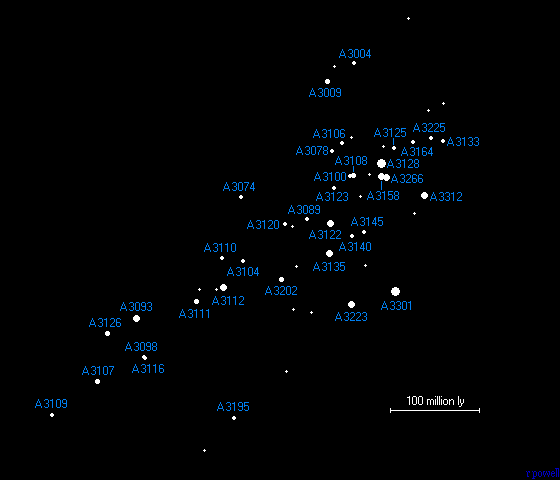
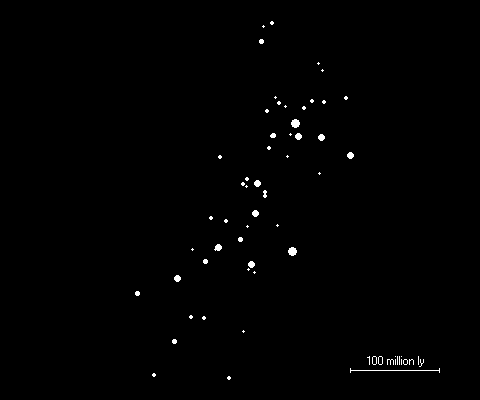
This is an animation of the Horologium Supercluster. This animation shows all the major clusters of galaxies listed above which are in this supercluster. The Horologium supercluster is very long, but it is also very thin. The supercluster is a very long wall of galaxies which is filled with a lot of very rich clusters of galaxies.
| Properties of the Horologium Supercluster (estimates) | |
|---|---|
| Length of the supercluster | 550 million light years |
| Mass of the supercluster | 1017 solar masses |
| Number of galaxy groups in the supercluster | 5 000 |
| Number of large galaxies in the supercluster | 30 000 |
| Number of dwarf galaxies in the supercluster | 300 000 |
| Number of stars in the supercluster | 1 million billion |
Below is a picture of the centre of the A3128 cluster. This cluster was number twenty in a list of twenty-five rich clusters which Harlow Shapley published in 1933. This cluster does not contain any of the gigantic elliptical galaxies sometimes found at the centre of rich clusters although there are certainly a lot of large galaxies here. This is the richest cluster of galaxies in the Horologium supercluster and one of the richest clusters within a billion light years from us.
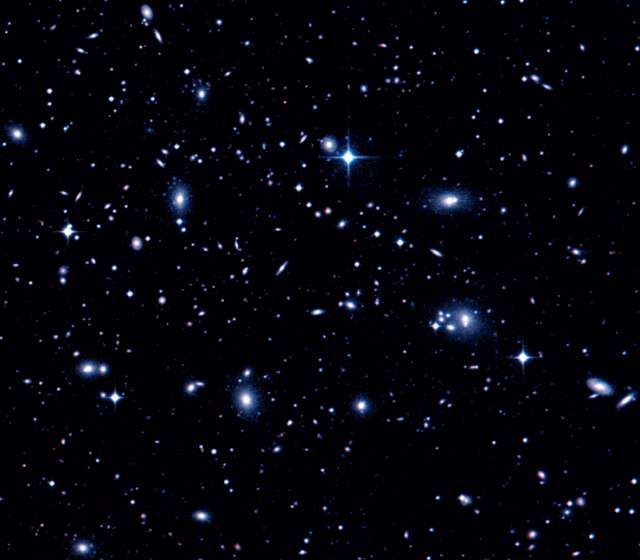
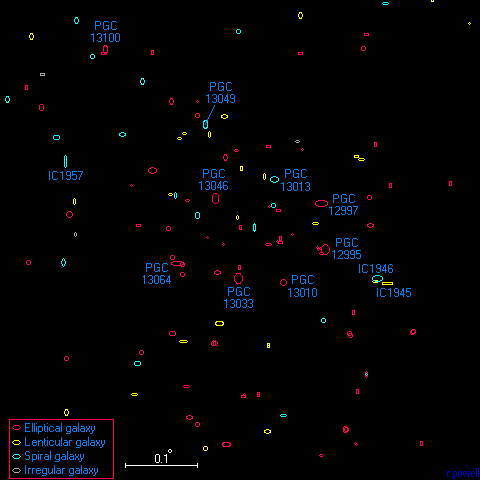
This is a map of the A3128 cluster. This map shows 128 of the brightest galaxies in this cluster. A few of these galaxies (including IC1946, IC1957 and PGC 12997) are foreground galaxies 250 million light years in front of the cluster. But most of the galaxies here (including IC1945) are in the cluster.
In 1899, Edward Pickering reported that one of his astronomers (De Lisle Stewart) at the Harvard Observatory had noticed a very faint "group of nebulae" in the constellation of Horologium. Although they would never know it, this was the first observation of the Horologium supercluster.
The next person to notice the Horologium supercluster was Harlow Shapley. In 1935, he published A Catalogue of 7889 External Galaxies in Horologium and Surrounding Regions. He noticed some rich clusters of galaxies and he wrote that the "groups of galaxies in this region are only concentrations in an extensive cloud of galaxies". He published some maps of the region including this map. The three main clusters on the map correspond to the clusters A3128, A3158 and A3164.
The first attempt to study this supercluster after Harlow Shapley was made by J Lucey, R Dickens, R Mitchell and J Dawe in 1983. They published a paper called The Horologium-Reticulum supercluster of galaxies. They surveyed a small part of the supercluster and published a simple map showing that there are two superclusters here - a small supercluster at 550 million light years and a larger supercluster at 800 million light years. In 1984, G Chincarini, M Tarenghi, H Sol, P Crane, I Manousoyannaki and J Materne also studied this supercluster. Their survey was not very sensitive, and it only revealed the smaller, nearer supercluster.
The Horologium supercluster is a remarkable supercluster. It is one of the largest and richest superclusters known. However, since 1984 it has been completely ignored. Not many astronomers have heard of the Horologium supercluster and many of those who have heard of it seem to be unaware of how large it is. A few astronomers are aware of its size, but noone has studied it in detail. This web page seems to be the first serious (although brief) attempt to describe the entire supercluster.
Below - a picture of the centre of the A3158 cluster of galaxies. This is another of the very rich clusters of galaxies in the Horologium supercluster and it lies at exactly the same distance as the A3128 cluster. The three largest elliptical galaxies in this picture are (from right to left) PGC 13641, ESO 156-8, and PGC 13679.
